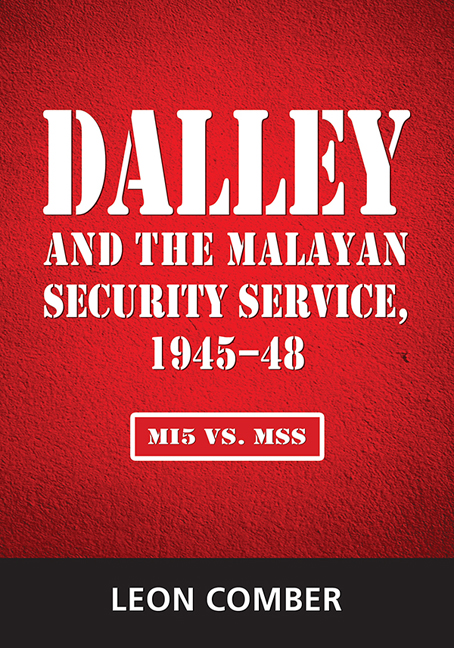Book contents
- Frontmatter
- Contents
- Preface
- Acknowledgements
- List of Abbreviations
- 1 Lieutenant Colonel John Dalley and the MSS: Early Days
- 2 Lieutenant Colonel John Dalley and Dalforce
- 3 The Establishment of “Security Intelligence Far East (SIFE)” in Singapore
- 4 Dalley's Return to Singapore
- 5 The Indonesian Situation and Malaya
- 6 Indonesian Encroachment into Malaya
- 7 Arrangements for Allocation of MSS Staff to Special Branch, Singapore, and Special Branch, Malaya
- 8 Conclusion
- Appendices
- Bibliography
- Index
- About the Author
1 - Lieutenant Colonel John Dalley and the MSS: Early Days
Published online by Cambridge University Press: 12 February 2019
- Frontmatter
- Contents
- Preface
- Acknowledgements
- List of Abbreviations
- 1 Lieutenant Colonel John Dalley and the MSS: Early Days
- 2 Lieutenant Colonel John Dalley and Dalforce
- 3 The Establishment of “Security Intelligence Far East (SIFE)” in Singapore
- 4 Dalley's Return to Singapore
- 5 The Indonesian Situation and Malaya
- 6 Indonesian Encroachment into Malaya
- 7 Arrangements for Allocation of MSS Staff to Special Branch, Singapore, and Special Branch, Malaya
- 8 Conclusion
- Appendices
- Bibliography
- Index
- About the Author
Summary
Who was Lieutenant Colonel John Douglas Dalley, Director of the Malayan Security Service (MSS), and what was the MSS?
Dalley was a senior pre-war officer of the Malayan Police who became Commander of Dalforce (named after him), an irregular guerrilla force that fought bravely against the Japanese when they invaded Malaya/Singapore in 1941, and later became Director MSS. An account of Dalforce will be given later in this study.
Dalley joined the Federated Malay States Police as a Cadet Assistant Superintendent of Police in November 1920 when he was twenty. That was the average age for Malayan/Singapore police gazetted officers to join the Malayan Police at that rank. After passing in due course the required Malayan Government examinations for gazetted police officers in police law, colonial regulations, Malayan Government regulations, weapon training and Malay language, Dalley was confirmed as an Assistant Superintendent of Police (ASP) in 1924.
How did the Malayan Security Service come into existence? The pre-war Inspector General of the Straits Settlements Police, A.H. Dickinson, provided an official account of the genesis of the early MSS and how it was founded when he included it in a list of British pre-war intelligence organizations that he prepared after WWII for Lieutenant General Arthur Earnest Percival, the ill-fated commander of the Allied forces in Malaya and Singapore who surrendered Singapore to the Japanese on 15 February 1942. Percival was then writing his dispatches at the War Office on the Malayan Campaign.2 Dickinson reported that the MSS was created in September 1939 at the suggestion of MI5, the UK domestic intelligence agency, which then included British overseas colonies within its remit, with the support of the colonial Singapore and Malayan Governments, when it seemed likely that the separate Special Branches in Singapore and Kuala Lumpur would need restructuring and refining to prepare for the possibility of war with Japan. It was established on a pan- Malayan basis as a coordinating and reporting body for political and security intelligence. Its headquarters were at Robinson Road, Singapore, and it had a Malayan branch in Kuala Lumpur, with an MSS officer based in nearly all of the Malayan States and territories. As such, it formed part of what was referred to as the “Singapore Fortress Defence Scheme”, which had both military and civil sections.
- Type
- Chapter
- Information
- Dalley and the Malayan Security Service, 1945–48 , pp. 1 - 12Publisher: ISEAS–Yusof Ishak InstitutePrint publication year: 2018

